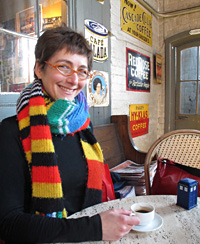 The Spun site has gone, so by popular demand here is my Basic Ribbed Sock pattern.
The Spun site has gone, so by popular demand here is my Basic Ribbed Sock pattern.
This sock design was developed as a solution to two problems: socks with a plain stocking-stitch leg tend to fall down, and I find k1p1 ribbing tedious.
Materials: 100 gm sock yarn – the samples used Fleece Artist’s Merino Sock yarn. This pattern works for any sock yarn with a 28-30 stitch gauge
1 set of 2.5mm double-pointed needles
Gauge:
32 stitches, unstretched, across 4 inches/10cm in K3 P1 rib with 2.5mm needles.
Method:
Cuff:
Cast 60 stitches onto a single needle. Distribute stitches evenly across 3 needles. Join, being careful not to twist.
Work 15 cm/6 inches of K3 P1 ribbing, as follows:
Round 1: *K3, p1; repeat from * to end of round. Repeat this for every round.
Turn Heel:
This portion is worked flat in plain stocking stitch.
Knit first 27 stitches. Put remaining 33 stitches onto a holder. Starting with a purl row, work 21 rows of stocking stitch, slipping the first stitch of every row. The right side is facing for next row.
RS: Knit 18 stitches, SKP, turn
WS: Slip 1, purl 9 stitches, p2tog, turn
RS: Slip 1, knit 9 stitches, SKP, turn
Repeat last two rows until all stitches have been worked. Ensure right side is facing for next row. 11 stitches remain on the needle.
Re-establish Round and Create Gusset:
Knit all heel stitches. Using that same needle, pick up and knit 15 stitches along selvedge edge at side of heel, using slipped stitches as a guide. With a new needle, work in pattern across the 33 stitches of instep – those stitches that you’d set aside on the stitch holder. Using another new needle, pick up and knit 15 stitches along selvedge edge at other side of heel, using slipped stitches as a guide. Work 6 stitches from the first needle.
The beginning of the round is now at the centre of the heel. There should be 20 stitches on the first needle, the 33 stitches of the instep on the second, and 21 on the third. Rearrange the stitches if you need to.
From here on in, the 33 instep stitches will be worked in the rib pattern, and the gusset and sole will be worked in stocking stitch – that is, knitting every round.
Decrease Gusset:
Work a round even – keeping the instep stitches in pattern – twisting all picked-up stitches.
Work a decrease round as follows:
Needle 1: Knit to last three stitches, k2tog, k1.
Needle 2: Work all stitches in pattern.
Needle 3: K1, ssk, knit to end.
Work an even round, keeping continuity of pattern.
Repeating these last two rounds until Needles 1 has 13 stitches and Needle 3 has 14. 60 stitches total on your needles.
Work until foot measures 5 cm/2 inches less than desired length.
Shape Toe:
From here on in, you’ll work entirely in stocking stitch. Rearrange the stitches so that you’ve got 15 each on Needles 1 and 3, and 30 on Needle 2.
Work a decrease round, as follows:
Needle 1: Knit to last three stitches, k2tog, k1.
Needle 2: K1, SSK, knit to last three stitches, k2tog, k1.
Needle 3: K1, SSK, knit to end.
Work 3 rounds even.
Work a decrease round followed by 2 even rounds, twice. [6 rounds total]
Work a decrease round followed by 1 even round, three times. [6 rounds total]
Work 7 more decrease rounds. 8 stitches remain.
To finish, either graft together final stitches or cut yarn, draw through the final stitches and tighten. Weave in ends.


 I've been working on Lace Wings since, oh, sometime in the spring.
I've been working on Lace Wings since, oh, sometime in the spring.















